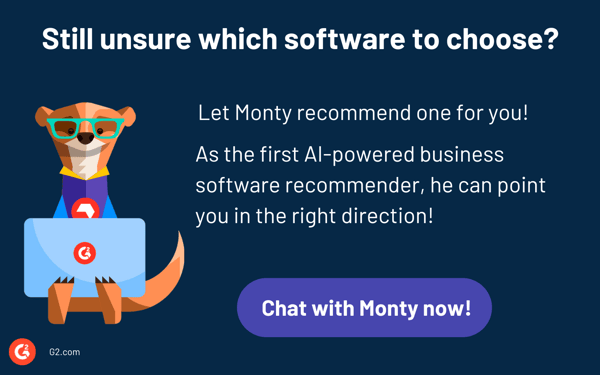When I started digging into restaurant POS systems, I didn’t expect to find so many options, each claiming to be the fastest, smartest, or most restaurant-friendly solution out there. But behind the flashy features and bold promises, what really matters is how well these systems support the day-to-day chaos of running a restaurant.
You’re not just looking for something that rings up orders. You need the best restaurant POS system that’s easy to use, helps manage everything from the front house to the kitchen, and actually makes life easier for you and your staff.
And you’re not alone in searching. The global restaurant point of sale (POS) terminal market was valued at $16.5 billion in 2021 and is projected to reach $44.6 billion by 2031.
While I don’t operate a restaurant myself, I analyzed leading restaurant POS solution reviews on G2, talked to different restaurant owners, compared feature sets, and identified which tools actually help their teams thrive in fast-paced food environments.
In this guide, I’ll break down the best restaurant POS systems based on what matters most: usability, features, flexibility, and how well each one fits different types of restaurants. Whether you’re just starting out or looking to upgrade, this guide is built to help you make a smart, confident choice.
6 best restaurant POS systems: My picks for 2025
- SpotOn: Best for growing restaurants with flexible features
Praised for outstanding customer support and fast menu management. (free plan, starts at $99/month) - Petpooja: Best for Indian restaurants needing regional support
Customizable menus and billing designed for local operations. ($117.50/year) - Square Point of Sale: Best for small teams on a budget
Free plan with intuitive order entry and smart stock control. (free plan, starts at $29+/month) - Clover: Best for all-in-one bundled POS with sleek hardware
Integrated payments, team management, and real-time reporting ($59.95/mo) - Restroworks Restaurant POS: Best for enterprise-grade control in Indian restaurants
Reliable billing and bulk menu updates with cloud access. (Available on request) - Toast: Best POS for restaurants of all sizes
Feature-rich platform with POS, payroll, and online ordering. ($69/month)
*These are the top-rated point of sale software for restaurants, according to G2’s Summer 2025 Grid® Report. I’ve included starting prices to help you compare options more easily. Pricing listed does not include payment processing fees, setup fees, or per-employee charges.
My top 6 best restaurant POS system recommendations for 2025
A restaurant POS system, in simple terms, is the central hub that keeps things running smoothly, from taking orders to processing payments to managing the flow between the front and back of the house.
When I first started looking into them, I thought they were just modern cash registers. But they’ve evolved into much more than that. Today’s POS systems help track inventory, manage tables, sync menus across in-person and online platforms, and even schedule staff shifts.
What makes the best restaurant POS system really comes down to how well it supports your day-to-day operations. In my research, the top performers were the ones that felt intuitive to use, offered flexible integrations with delivery and payment platforms, and came with responsive customer support.
A great POS system doesn’t just keep the orders moving. It helps reduce chaos during peak hours, improves communication between servers and the kitchen, and gives you the data you need to make smarter business decisions.
According to G2 Data, restaurant POS systems have an average adoption rate of 86% and deliver ROI in as little as 17 months, proving that these tools don’t just streamline operations; they pay off quickly.
How did I find and evaluate the best restaurant POS systems?
To make sure I was recommending restaurant POS systems that actually meet the needs of busy food service teams, I started with a shortlist based on the top-rated products on G2.
I researched extensively to understand how each platform performed when it came to essential features like order management, table tracking, menu syncing, staff scheduling, and integrations with delivery services.
On top of that, I connected with restaurant professionals who’ve used these POS platforms in real-world settings and validated their feedback against verified G2 user reviews. I also used AI to analyze trends in G2 user reviews, surfacing common complaints, standout features, and the everyday realities of using these tools in fast-paced restaurant environments.
The screenshots included in this article come from the vendors’ G2 profiles or other publicly available resources.
What I look for in restaurant POS systems
In comparing restaurant POS systems, I focused on features that genuinely help streamline service, improve operations, and make day-to-day tasks easier for restaurant teams. Here’s what I paid the most attention to:
- Ease of use: A good POS should be quick to learn and effortless to navigate. I looked for systems that servers, cashiers, and kitchen staff can pick up with minimal training — especially important in restaurants with high turnover.
- Order and table management: Whether it’s handling dine-in, takeout, or online orders, the POS should route tickets efficiently and keep things organized. I paid attention to features like real-time order updates, table status views, and server section assignments.
- Menu flexibility: I looked for platforms that make it simple to update menu items, prices, and availability. Bonus points for those that support modifiers, combos, and seasonal changes without requiring a support call.
- Delivery and third-party integrations: Many restaurants rely on delivery apps, so I prioritized POS systems that integrate with platforms like Uber Eats, DoorDash, and Grubhub, along with payment processors and loyalty tools.
- Inventory tracking: I gave extra weight to systems that automatically update stock levels as items are sold. Real-time alerts, low-stock notifications, and ingredient-level tracking help reduce waste and avoid surprises.
- Hardware options: Some systems offer all-in-one hardware bundles. Others let you use existing tablets or mix and match devices. I looked at what each platform offers, whether it’s mobile POS setups, kitchen display systems, or self-service kiosks.
- Reporting and analytics: I looked for systems that break down sales, labor costs, and menu performance in a clear, visual way. Real-time dashboards and automated reports help restaurant owners make faster, smarter decisions.
- Customer support: Things break, especially during the dinner rush. I prioritized platforms known for responsive, helpful support through live chat, phone, or email, with coverage during peak hours.
- Transparent pricing: I favored systems that clearly outline their costs upfront, including monthly fees, hardware charges, and transaction rates.
The list below contains genuine user reviews from our best restaurant POS software category page. To qualify for inclusion in the category, a product must:
- Take orders from a menu and submit those orders to the kitchen for multiple guests or tables.
- Process payments using various methods such as cash, credit or debit card, as well as split checks and add discounts.
- Offer secure data access and functionality to protect sensitive data such as customer information and credit card numbers.
- Include reporting and analytics to monitor sales indicators for each location, as well as order cancellations.
This data was pulled from G2 in 2025. Some reviews have been edited for clarity.
1. SpotOn: Best for growing restaurants with flexible features
SpotOn is still a relatively newer entrant in the POS space, especially compared to giants like Toast or Square. It launched in 2017, but based on my research, I could see that it’s already made a name for itself by focusing on service and speed and actively rolling out improvements based on user feedback.
![]()
One thing that stood out to me in the G2 reviews I read right away was how often users praised SpotOn’s customer support. It wasn’t just a vague “they’re helpful.” People mentioned specific reps by name, talking about them like trusted teammates. That kind of consistent human support is rare in this space, and it makes a big difference when your system hits a hiccup during a dinner rush.
From a feature standpoint, SpotOn really shines in menu management and order handling, according to what I gathered. G2 reviews mentioned how quick it is to make changes on the fly, which is a big win for places that constantly rotate specials. The system is also praised for its speed and responsiveness. Staff can take and modify orders quickly, even when things get hectic.
I saw that it integrates with tools like MarginEdge, Craftable, BevSpot, Cogs-Well, and more, letting restaurants pull in inventory reports right alongside POS sales data. For payroll, it syncs with popular platforms like Gusto, ADP, Paylocity, and Paychex, making back-office tasks way less painful. And if you’re handling delivery, you’re covered there too. So you can manage online ordering and delivery without the usual mess of disconnected platforms.
That said, it’s not perfect. I noticed a few G2 users pointing out that the backend could be more intuitive. Things like the absence of a “save” button in certain menus or the hassle of juggling multiple logins for different modules came up as pain points. Some reviewers on G2 noted that a few parts of the system feel like they could be more polished, but overall, it seems SpotOn is iterating quickly based on feedback.
In my opinion, it may not be as mature as some older platforms, but that also means it’s more agile and open to change. I’d say SpotOn is ideal for small to mid-sized restaurants, bars, and hospitality businesses that want strong core features, a responsive support team, and enough flexibility to grow and evolve with their operations.
SpotOn offers a Quick Start plan at $0/month, designed for smaller cafes or counter-service restaurants that comes with display and the essential functionalities. It includes a processing fee of 2.89% + 25 cents.
The freeplan makes SpotOn one of the best restaurant POS system for small businesses, along with other tools like Square, and Toast, in my view. For those who need more advanced features like employee management, kitchen display systems, or larger hardware bundles, there are paid plans starting at $99/month.
What I like about SpotOn:
- I love how easy it is to update menus on the fly. It’s perfect for busy shifts when you need to add specials or make quick changes.
- G2 reviewers highlight the support team as fast, personal, and consistent, with many calling reps out by name.
What G2 users like about SpotOn:
“I joined Spot-On a little over two years ago and switched over two of my restaurants. I wanted a POS system that could offer great flexibility with menu creation, great access to reporting, and a seamless experience without any bottlenecks or tech issues.
I got EXACTLY THAT! The reporting is so in-depth and helpful when making business decisions on what products are selling and what ones aren’t. The fact that you can see everything live, too, is amazing. You can see not only how many of an item is sold but also who sold it, what time of day, what it was paired with, and any discounts/voids applied. It made running our restaurants much more efficient and was a huge time saver!
The implementation process when we initially joined was very solid and thorough. When I asked if we could have certain items set up in certain ways, the answer was always yes! It was so satisfying to see Spot-On visualize exactly what I wanted in my head. We use Spot-On now for three of our businesses and utilize their Restaurant POS as well as online credit card processing for ticket sales in our concert venue. It was super easy to integrate all of our data into their system!”
– SpotOn Review, Collin W.
What I dislike about SpotOn:
- The backend could be more intuitive in places. I’ve seen multiple mentions of confusing layouts and missing buttons, like not having a clear “save” option when editing settings.
- Managing multiple modules sometimes feels clunky. Needing separate logins for different functions adds friction, especially when you’re trying to move fast during service.
What G2 users dislike about SpotOn:
“There are too many logins and separate software programs. As an owner, one login with one dashboard for back office, reporting, labor, etc…would make life easier.”
– SpotOn Review, Janet J.
2. Petpooja: Best for Indian restaurants needing regional support
Petpooja consistently came up as a top restaurant billing software choice for food and beverage businesses in India. Based on the feedback on G2, I could see that it’s designed with the realities of Indian restaurant operations in mind, and it strikes a solid balance between customization, reliable support, and everyday functionality.

What users love most about Petpooja is how customizable the platform is. Whether it’s the menu layout, billing options, or specific workflows, the system seems flexible enough to adapt to each restaurant’s setup. The backend service and support team also got a lot of praise. People called out timely updates, responsive assistance, and even specific service reps who helped them navigate issues quickly.
Another standout is Petpooja’s ability to help restaurant owners track sales, expenses, and menu performance in detail. Real-time reports and automation features let teams operate more efficiently. Some even said they’re able to run their restaurant on “autopilot” thanks to these tools.
That said, a few consistent drawbacks came up across user reviews on G2. The most common one was around inventory management. While the feature is there, many users found it clunky.
I also saw several mentions of slow turnaround times when it comes to resolving issues or getting support. While G2 reviewers noted that the backend team is generally seen as helpful, some felt the wait times could be shorter.
So, would I recommend it? Yes. Based on everything I’ve seen, I’d say Petpooja is a great fit for independent restaurants, cafés, cloud kitchens, and small chains across India. It’s clearly built with local operations in mind.
What I like about Petpooja:
- From what I’ve seen, users really appreciate how customizable the system is, from menu setup to billing options. That flexibility seems to be a big advantage for different types of restaurants.
- The backend support team gets a lot of positive mentions. People talk about timely updates and helpful service, which tells me there’s a solid team behind the product.
What G2 users like about Petpooja:
“Petpooja is a restaurant-all-in-one solution application that offers features like integration with Zomato and Swiggy, quick billing, various reports with graphical representation, customer reviews, menu updates, and inventory management. These features make it an essential solution for restaurant owners.”
– Petpooja Review, Vineet R.
What I dislike about Petpooja:
- One thing that came up a lot during my research was the inventory module. It works, but some users find it lagging
- I also noticed several reviews mentioning long turnaround times for resolving issues and that the UI could be improved to make navigation smoother.
What G2 users dislike about Petpooja:
“Took so much time in menu updation from the backend team.“
– Petpooja Review, Verified user from the food and beverages industry.
3. Square Point of Sale: Best for small teams on a budget
Square POS was one of the first POS software I came across when I started researching the best restaurant POS systems, and it’s easy to see why it’s such a popular choice, especially for newer or growing businesses. It’s known as one of the most affordable restaurant POS systems and surprisingly powerful for the price.

One thing I appreciate right off the bat is how easy it is to get started. Square offers a completely free plan for small teams, which includes essentials like menu management, offline payments, bar tabs, and staff time tracking (has a processing fee). You also get phone support during business hours. And if you’re looking to grow, there’s a 30-day free trial of the paid plans, so you can try out advanced features before committing.
From the G2 reviews I read, ease of use is a recurring theme. Restaurant owners and managers say it’s quick to learn and easy to train new staff on. The interface is clean, intuitive, and works just as well for full-service restaurants as it does for cafes or food trucks. I saw several users mention that customization options are solid too, whether you want to build out a floor plan, split checks, or set up seat-level ordering.
What also stood out to me during my research was how Square balances simplicity with smart functionality. Order entry is fast and intuitive, with a customizable layout and even menu photos to speed things up during service. You can also set auto-86 rules and item counts, which help prevent overselling by adjusting menu availability based on stock, something restaurants really appreciate when the kitchen runs low mid-shift.
Another thoughtful touch is the option to send automatic order-ready texts to customers. It’s a small feature, but it keeps pickups organized and minimizes crowding at the counter. And for restaurants that want to streamline even further, Square also offers a self-service Kiosk, letting guests build and place their own orders, great for quick-service spots or busy lunch rushes.
While Square is receptive to feedback, support can be a mixed experience based on the feedback I read on G2. Some users love it, while others find it a bit inconsistent, depending on the issue or time of day.
I also encountered a few G2 users mentioning feature limitations, particularly when it comes to more nuanced workflows like applying discounts to item combinations or hiding certain POS buttons. Some mentioned that those kinds of requests have been floating around for years without resolution. Square is always improving and pushing updates, but because it serves such a broad customer base, some specialized requests may take longer to address.
Still, Square is a great fit for restaurants, cafes, and food trucks that want a straightforward system without a huge upfront investment. If you’re just getting started or managing a lean team, it’s hard to beat the value of the free plan.
What I like about Square Point of Sale
- From what I’ve gathered, the order entry process is quick and intuitive. The layout is clean, customizable, and designed to help staff move fast.
- Users also frequently mention how easy it is to manage menus. Features like auto-86ing and live item counts help prevent overselling, which is a huge win in fast-paced environments.
What G2 users like about Square Point of Sale
“Everything! We love Square! We are on the beta team for Square for Restaurants, and everyone is so pleasant to work with. I love how everything integrates into Square, and when we have a feature that we would love to see, Square is there to listen to us. Everything is so easy to set up and fairly easy to understand. What I love as well is that we are able to easily pack up our POS for when we have off-site events, which is very often during the summer months.”
– Square POS Review, Joseph B.
What I dislike about Square Point of Sale
- I noticed some users pointing out that certain feature requests, especially more specific or nuanced ones, have been on the radar for a while but still haven’t been fully addressed.
- I saw that user feedback on Square’s customer support is mixed. Some users mentioned delays and inconsistency, while others didn’t flag support as a major issue at all.
What G2 users dislike about Square Point of Sale
“Being such a large company, Square sometimes overlooks unique feature requests from smaller businesses. This can mean that some of the specialized needs or innovative ideas don’t always get the attention or development they might in a more niche-focused POS provider.
However, this is a minor complaint when set against the backdrop of all the benefits Square brings to the table. The positives overwhelmingly outweigh these small negatives, making Square an indispensable part of our daily operations.”
– Square POS Review, Luke N.
4. Clover: Best for all-in-one bundled POS with sleek hardware
As I started digging into Clover, what stood out to me immediately was how versatile it is. A lot of users, from retail stores to cafés and restaurants, mentioned on G2 that Clover works well across business types, which is a huge plus if you’re looking for flexibility. The system seems designed to adapt, whether you’re managing a boutique, a quick-service restaurant, or even a salon.

From the G2 feedback I gathered, it’s a modern-looking system with a fairly clean dashboard, and users often mention that it’s easy to take payments, check sales data, and navigate day-to-day operations.
If you’re managing multiple locations or want something that integrates with various apps, Clover offers that kind of all-in-one experience with real-time reporting, team management, and inventory tracking all under one roof.
That said, a few limitations came up in user feedback during my research on G2. Some G2 reviewers found the setup process less smooth than expected, especially when dealing with account verification or onboarding steps.
A few others on G2 noted that reporting from the POS device itself is limited, requiring them to log into the web dashboard to access detailed insights, which may not work for everyone’s workflow, in my opinion. But overall, users say Clover is a versatile, and user-friendly POS system that works well for many types of businesses.
What I like about Clover:
- From what I’ve seen, Clover’s interface is clean and easy to use. A lot of users said their staff picked it up quickly, which makes onboarding way less of a hassle.
- I like that it offers an all-in-one experience — inventory, payments, team management, and reporting are all integrated, which saves time and keeps things streamlined.
What G2 users like about Clover:
“Easy to take payment. Easy to access payment data. Generally simple dashboard to navigate.”
– Clover Review, Sandrine M.
What I dislike about Clover:
- Some users mentioned that setup and onboarding could be smoother, especially with account verification and initial hardware configuration.
- One thing I noticed is that reporting from the POS device can be limited. You often have to log into the web dashboard for detailed insights, which might not be ideal for everyone.
What G2 users dislike about Clover:
“I wish there were more flexibility with the equipment, allowing for easier upgrades from one processor to another when needed. An approval process for such changes would be a helpful addition.”
– Clover Review, Jason W.
5. Restroworks Restaurant POS: Best for enterprise-grade control in Indian restaurants
As I started reading through G2 reviews of Restroworks, formerly Posist, what really stood out to me was how often people praised the system’s reliability and ease of use.
It’s clearly built for restaurants, and most users mentioned how intuitive it is, especially when it comes to billing, menu management, and day-to-day handling of front-of-house operations. A lot of the feedback I came across talked about how simple it is for staff to navigate and how quickly teams adapt to using it.
 Restroworks also seems to do well on the backend, from what I saw. Users mentioned that reports and billing data are available on time, integrations with other systems work smoothly, and cloud syncing makes it easy to keep everything accessible.
Restroworks also seems to do well on the backend, from what I saw. Users mentioned that reports and billing data are available on time, integrations with other systems work smoothly, and cloud syncing makes it easy to keep everything accessible.
It’s the kind of setup that gives restaurant managers visibility without being too complicated or technical. A few users even said they’re able to manage things like menu updates in bulk using CSVs, which is a major time saver.
That said, no system is perfect. A few users on G2 pointed out that while the platform handles reporting well overall, some reports could use more flexibility or customization to meet daily operational needs.
And while most people had good experiences with the support team, a couple mentioned delays in reaching them during peak times. These aren’t dealbreakers, but they’re worth knowing going in.
From what I’ve seen, Restroworks hits a great balance between functionality and simplicity. It’s packed with features but doesn’t feel bloated. So, if you’re running a restaurant, café, or even a hospitality business in India, I’d say Restroworks is definitely worth a look.
What I like about Restroworks Restaurant POS:
- From what I’ve seen, billing and reporting are big strengths. Users say reports are generated on time and are easy to access, which helps a lot with tracking sales and making quick decisions.
- Menu management also seems super efficient — some users even mentioned being able to update items in bulk using CSV files, which sounds like a huge time saver.
What G2 users like about Restroworks Restaurant POS:
“I’ve used many POS systems throughout my career — some highly versatile, others frustratingly rigid. However, this is the first time I’ve encountered a POS that anticipates exactly what I need, offering the perfect balance of functionality and flexibility. It seamlessly integrates all the features I want, optimizing the experience for both business owners and users alike.”
– Restroworks Restaurant POS Review, Viraf P.
What I dislike about Restroworks Restaurant POS
- A common complaint I came across was that support can be slow to respond, especially during busy hours. That could be a real headache if something breaks mid-shift.
- A few users said the reports, while generally solid, could use more customization to better fit their day-to-day operational needs.
What G2 users dislike about Restroworks Restaurant POS:
“Support team needs improvement, they take a lot of time in resolving the tickets.“
– Restroworks Restaurant POS Review. Omar S.
6. Toast: Best POS for restaurants of all sizes
When you’re talking about restaurant POS systems, it’s impossible not to mention Toast. It’s one of the most well-known platforms in the industry, and is recoginized as one of the best all-in-one POS app for restaurants. After going through hundreds of user reviews on G2, it’s clear to me why it consistently shows up at the top of the list.
Toast is built specifically for restaurants, and it really shows in the way it handles day-to-day operations. From the interface to the workflows, it feels like it’s designed with hospitality in mind, not retrofitted from a retail system.
 What I kept seeing in the reviews was just how feature-rich and scalable Toast is. Whether you’re running a small local café or a multi-location restaurant group, Toast seems to offer the tools to grow with you. Users frequently called out its sleek, modern UI and how easy it is for staff to pick up.
What I kept seeing in the reviews was just how feature-rich and scalable Toast is. Whether you’re running a small local café or a multi-location restaurant group, Toast seems to offer the tools to grow with you. Users frequently called out its sleek, modern UI and how easy it is for staff to pick up.
Features like order routing to the kitchen, integrated online ordering, tip tracking, and payroll tools came up again and again as major wins. There’s also the Toast display screen, which helps keep orders visible and accurate in high-volume settings. It’s the kind of setup that can really help service during rush hours.
But like any platform, Toast isn’t perfect. One thing that stood out on G2 reviews was the mixed feedback on customer support. Some users had great onboarding experiences and found the interface intuitive, but few others noted long wait times or felt that support was inconsistent, especially when dealing with urgent issues.
I also noticed a handful of G2 reviewers feeling that certain actions within the system were overly complicated, especially when it came to personal reporting or accessing specific functions quickly. There are definitely a few things that could be improved, but Toast still stands out as one of the most complete, restaurant-focused POS platforms out there.
From everything I’ve read on G2 , it offers a really robust ecosystem — handling POS, payments, online ordering, team management, and more, all in one place.
And for most restaurant operators, that kind of integration is exactly what they need. It’s one less thing to worry about when everything from the front of house to the back is connected and running through a single system.
If I were opening a new spot, expanding to more locations, or just needed something that could keep up with a busy kitchen and dining floor, Toast would be at the top of my list. It’s not just popular. It’s proven, and there’s a reason so many restaurants stick with it.
What I like about Toast:
- From what I’ve seen, Toast has a really modern and easy-to-use interface. A lot of users said their staff picked it up quickly, which is a big plus in a busy restaurant setting.
- I also like how it pulls together so many tools into one system — POS, payments, online ordering, team management, even payroll. That kind of all-in-one setup really simplifies things.
What G2 users like about Toast:
“We use Toast for all of our restaurant needs, including POS, Payroll, Marketing, and Invoices/Inventory. The way the system integrates everything is so nice, and we have so much information at our fingertips, crucial for running in a low-margin industry.
We also love their hardware. It seems Toast has really thought hard about how the POS and KDS systems work. We just installed a new KDS screen this week, and it was actually a joy to mount and get up and running. We had it ready to go in less than 30 minutes. It was just so easy.
Also, the online video library and support site are very good.”
– Toast Review, Craig W.
What I dislike about Toast:
- One thing that came up often is that support can be hit or miss. Some users had a smooth onboarding, but others said they struggled to get timely help when something went wrong.
- A few users also mentioned that despite the sleek look, the system isn’t always user-friendly. Some features take too many steps to access, and it can feel overly complicated for simple tasks.
What G2 users dislike about Toast:
“Customer support was terrible when I last used it in 2023. They typically outsource their customer support staff, who work remotely, and they had no idea what I talked about when I called them. Their restaurant success managers are also kind of useless, as we had one, and she wasn’t very helpful. The network team was awesome, though, because they were super smart and knew what I was talking about right away whenever we had issues with connections.”
– Toast Review, Verified user in Restaurants.
Best restaurant POS systems: Frequently asked questions (FAQs)
1. How do I choose the best restaurant POS systems?
The best POS system for restaurants depends on the size and type of restaurant, as well as the specific features needed. Key considerations include ease of use, order and table management, menu flexibility, reporting capabilities, hardware requirements, customer support, and integration with third-party tools like online ordering or delivery platforms.
2. Are there free POS systems for restaurants?
Yes, several providers offer free or entry-level plans. For example, Square and SpotOn have $0/month options with basic POS features included, though they typically charge per transaction. These free plans are best suited for small or new restaurants and may have limitations compared to paid tiers
3. Are free restaurant POS systems any good?
Some POS providers, like Square and SpotOn, offer free plans with core features included. These are great if you’re just starting out or have a small team. But just know that “free” often comes with trade-offs like limited reporting, basic hardware, or transaction-based pricing. I’d recommend testing them out if you’re on a tight budget, but plan for potential upgrades as you grow.
4. Can I use my own hardware with the POS systems?
It depends on the platform. Some systems, like Square, offer flexibility with tablets or mobile devices, while others might require their own proprietary hardware. This is definitely something to check before committing, especially if you already have existing equipment.
5. How much should I expect to spend on a restaurant POS system?
POS system pricing really varies. Some plans start at $0/month and only charge per transaction, while more advanced setups can cost $100–$300/month or more, depending on features, add-ons, and hardware. It’s not just about the monthly fee either; Look at processing rates, equipment costs, and what’s included in each tier.
6. What is the most reliable POS software for cafes?
According to G2 reviews, Square, Clover, and SpotOn are top picks for cafes. Square is praised for quick setup and ease of use, Clover for its sleek hardware and all-in-one design, and SpotOn for responsive support and fast order handling. Other reliable cafe-friendly options include Lightspeed and Revel Systems.
7. What’s the best restaurant management software with POS?
Tools like Toast, Clover, and SpotOn stand out in G2 reviews for combining POS with restaurant management features. Toast covers payroll, scheduling, and marketing; Clover bundles payments, reporting, and inventory; SpotOn integrates with payroll and inventory tools for a wider management suite. Enterprise players like Oracle MICROS and Revel Systems also rank high.
8. What’s the top restaurant POS for high-volume diners?
For high-traffic restaurants, G2 reviewers recommend Toast, Restroworks, and SpotOn. Toast handles peak service with KDS and order routing, Restroworks (formerly Posist) delivers reliability and real-time reporting, and SpotOn is praised for speed and menu flexibility. Other strong choices include Revel Systems and Lightspeed.
9. What’s the best restaurant POS platform with inventory tracking?
On G2, SpotOn, Toast, and Petpooja get the most mentions for inventory. SpotOn integrates with platforms like MarginEdge for real-time cost insights, Toast tracks ingredients to prevent overselling, and Petpooja offers built-in expense and sales tracking. TouchBistro and Revel Systems are also popular for strong inventory features.
10. Which POS software is best for multi-location restaurants?
G2 reviews highlight Clover, Restroworks, and Toast for multi-location setups. Clover centralizes reporting and staff management, Restroworks scales smoothly with cloud-based control, and Toast unifies operations across outlets. Larger groups also rely on Lightspeed and Oracle MICROS Simphony for enterprise-grade control.
Check, please!
After digging into all these platforms, what really stuck with me wasn’t just the features or the pricing. It was how each POS system reflects a different philosophy about how restaurants work. Some focus on speed above all, some prioritize customization, and others try to do everything under one roof.
What surprised me most was how much a good POS can influence the flow of an entire shift. It’s not just about ringing up orders or printing receipts. It’s about how quickly a server can modify a ticket, how clearly the kitchen sees those orders, and how easy it is for a manager to track what’s selling and what’s sitting. The right system creates calm in the chaos. The wrong one? It adds to it.
So, whether you’re just starting out or looking to upgrade, think beyond the basics. Look for a POS that understands your pace, supports your staff, and scales with your vision. Because in a business where every second and every plate counts, your tech should be working just as hard as you are.
Discover the top retail trends 2025 and learn how they’re reshaping the industry.
















